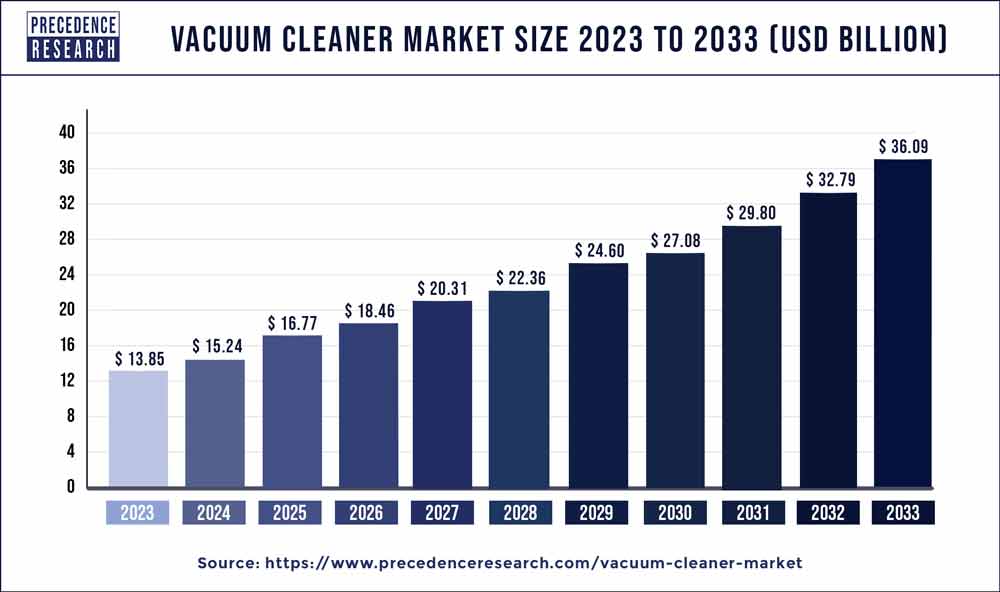The vacuum cleaner market is a dynamic sector within the broader household appliances industry. This overview aims to explore the key factors influencing the growth and development of the vacuum cleaner market, including market trends, drivers, opportunities, and challenges. As households increasingly prioritize cleanliness and hygiene, the demand for efficient and technologically advanced vacuum cleaners has witnessed significant growth.

Key Points
- North America dominated the vacuum cleaner market in 2023.
- Asia Pacific is projected to emerge as a significant player in the market.
- By product, the versatile vacuum cleaner segment held the largest share of the market in 2023.
- By product, the wet/dry vacuum cleaner segment is expected to witness the fastest growth during the forecast period.
- By distribution channel, the online marketplace segment held a significant share of the in 2023.
- By distribution channel, the specialty home appliance stores segment is projected to experience substantial growth in the coming years.
- By end user, the residential consumer segment held the dominating share of the market in 2023.
- By end user, the commercial consumers segment is observed to witness a significant rate of expansion during the forecast period.
The vacuum cleaner market encompasses a wide range of products designed to meet diverse consumer needs. Traditional upright vacuum cleaners, canister vacuum cleaners, handheld vacuum cleaners, and robotic vacuum cleaners are among the various types available in the market. Factors such as design, suction power, energy efficiency, and additional features contribute to the differentiation of products, creating a competitive landscape where manufacturers strive to meet evolving consumer preferences.
Get a Sample: https://www.precedenceresearch.com/sample/3840
Growth Factors
One of the primary growth factors driving the vacuum cleaner market is the increasing awareness of health and hygiene. Consumers are placing greater emphasis on maintaining clean indoor environments, particularly in the context of health concerns and the prevalence of respiratory issues. This heightened awareness has led to a surge in demand for vacuum cleaners equipped with advanced filtration systems that effectively capture allergens and particulate matter.
Technological advancements also play a crucial role in the growth of the market. Smart and connected vacuum cleaners, equipped with features such as app-based control, mapping capabilities, and voice integration, are gaining popularity among tech-savvy consumers. The integration of artificial intelligence (AI) and sensor technologies enhances the efficiency and autonomy of robotic vacuum cleaners, contributing to their widespread adoption.
Vacuum Cleaner Market Dynamics
Drivers
Efficiency and convenience are key drivers influencing consumer choices in the vacuum cleaner market. Manufacturers are focused on developing lightweight, compact, and user-friendly vacuum cleaners that offer powerful suction capabilities. Additionally, the transition to cordless and battery-powered vacuum cleaners addresses the need for mobility and flexibility, allowing users to clean various spaces without the constraints of power cords.
The growing trend of dual-income households and busy lifestyles has increased the demand for time-saving and labor-reducing appliances. Vacuum cleaners equipped with features such as automatic cleaning schedules and self-emptying dustbins cater to consumers seeking convenient solutions for maintaining clean homes with minimal manual effort.
Opportunities
As environmental sustainability becomes a central concern, there is an opportunity for the vacuum cleaner market to embrace eco-friendly practices. Manufacturers can explore the development of energy-efficient models, incorporate recyclable materials, and implement sustainable manufacturing processes to appeal to environmentally conscious consumers.
Furthermore, expanding into emerging markets presents a significant opportunity for growth. Rapid urbanization, increasing disposable incomes, and a growing awareness of household hygiene in developing regions create a favorable environment for the penetration of vacuum cleaner products. Strategic marketing and product adaptation to local preferences can help manufacturers tap into these burgeoning markets.
Challenges
Despite the overall positive outlook, the vacuum cleaner market faces certain challenges. Economic uncertainties and fluctuations in consumer spending patterns can impact the purchasing decisions of consumers, leading to a potential slowdown in market growth. Additionally, intense competition among manufacturers may result in pricing pressures, affecting profit margins and hindering investments in research and development.
Consumer education and awareness also pose a challenge, especially in markets where traditional cleaning methods are deeply ingrained. Manufacturers need to actively communicate the benefits of advanced vacuum cleaner technologies and address any misconceptions regarding their usage, maintenance, and overall value proposition.
Read Also: US Pain Management Drugs Market Size, Trends, Report by 2033
Recent Developments
- In August 2023, Dyson unveiled its latest innovation, the ‘Dyson All-in-One Wet-and-Dry Cordless Vacuum Cleaner,’ addressing the limitations of existing wet-and-dry formats. This groundbreaking product offers versatile cleaning solutions, allowing users to tackle dust, spills, and stains with ease.
- In January 2024, global brand ILife expanded its product portfolio in India with the launch of two new robot vacuum cleaners, the T10s and V3x. These devices offered a combination of hybrid wet-and-dry cleaning, aiming to simplify the living environment while enhancing cleanliness.
Vacuum Cleaner Market Companies
- Dyson
- TTI
- Electrolux
- Shark
- Bissell
- Panasonic
- Philips
- Whirlpool
- Bosch
- Deerma
- Roborock
- SUPOR
Segment Covered in the Report
By Product
- Upright Vacuum Cleaners
- Canister Vacuum Cleaners
- Handheld Vacuum Cleaners
- Stick Vacuum Cleaners
- Robotic Vacuum Cleaners
- Wet/Dry Vacuum Cleaners
- Backpack Vacuum Cleaners
- Commercial/Industrial Vacuum Cleaners
- Durable vacuum cleaners
- Versatile vacuum cleaners
By Distribution Channels
- Retail Stores
- Online Marketplaces
- Department Stores
- Specialty Home Appliance Stores
- Supermarkets/Hypermarkets
- Direct Sales (Manufacturer’s website)
- Wholesale Distributors
- Industrial Supply Stores
- Commercial Cleaning Suppliers
- Catalog Retailers
By End User
- Residential
- Commercial
- Industrial
By Geography
- North America
- Europe
- Asia-Pacific
- Latin America
- Middle East and Africa
Contact Us:
Mr. Alex
Sales Manager
Call: +1 9197 992 333
Email: sales@precedenceresearch.com
Web: https://www.precedenceresearch.com
Blog: https://www.expresswebwire.com/
Blog: https://www.uswebwire.com/
